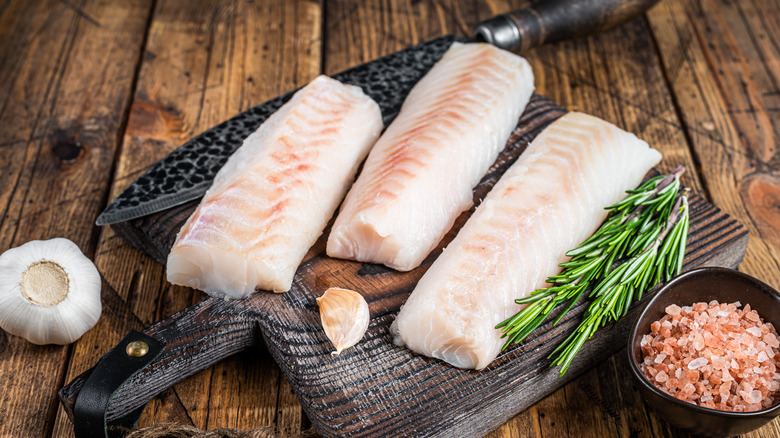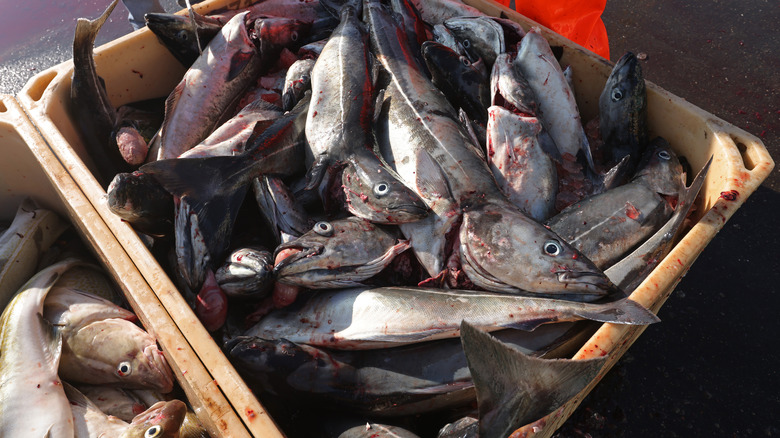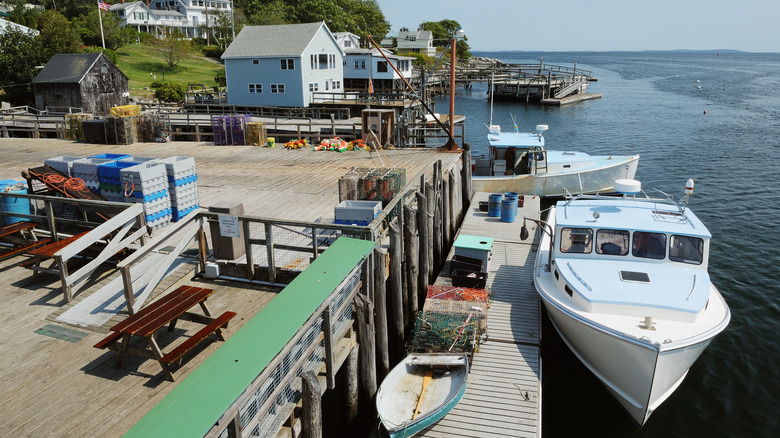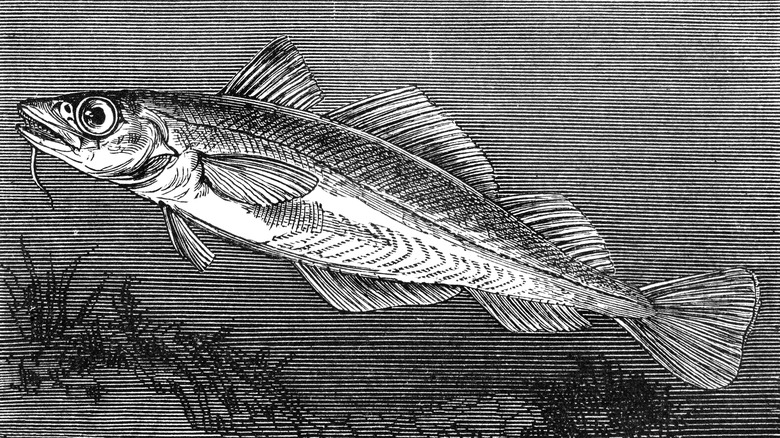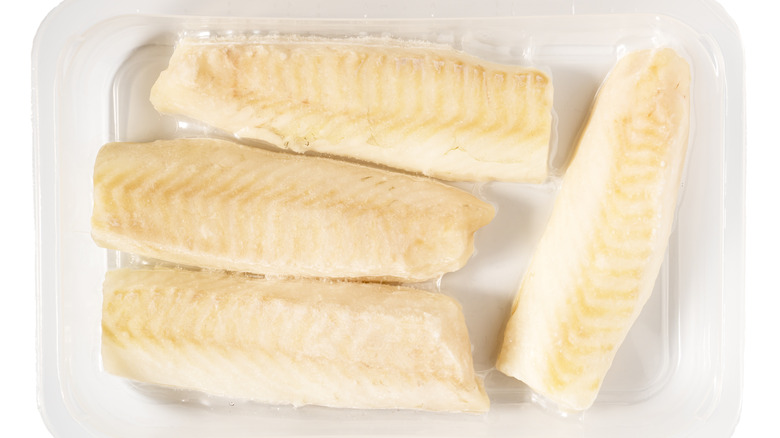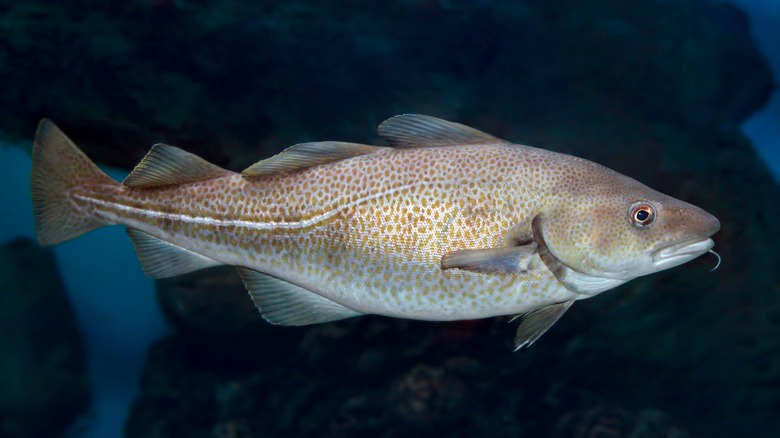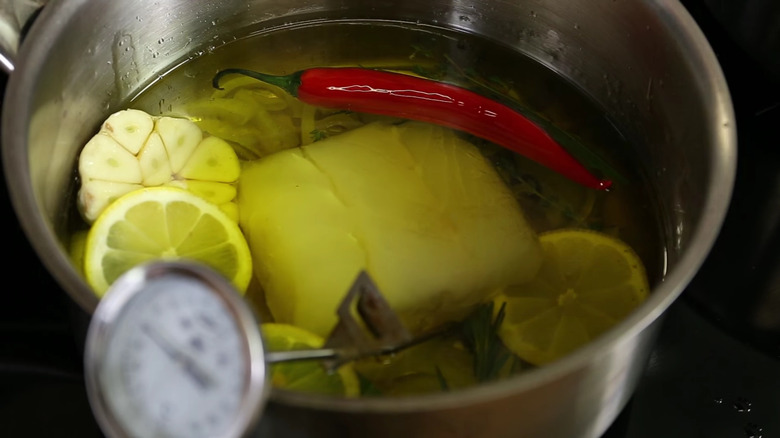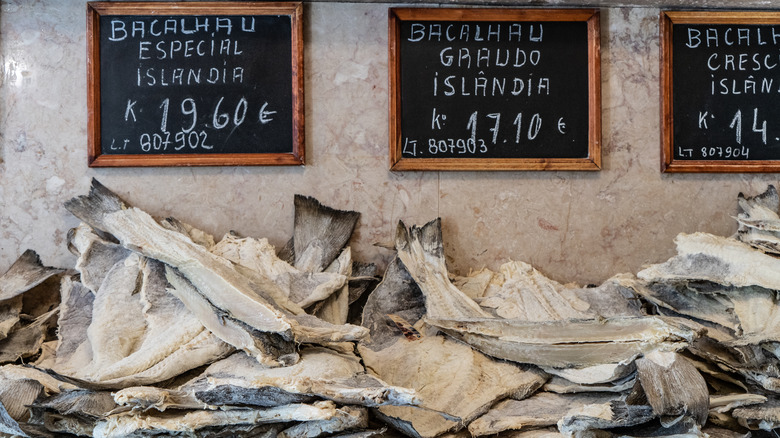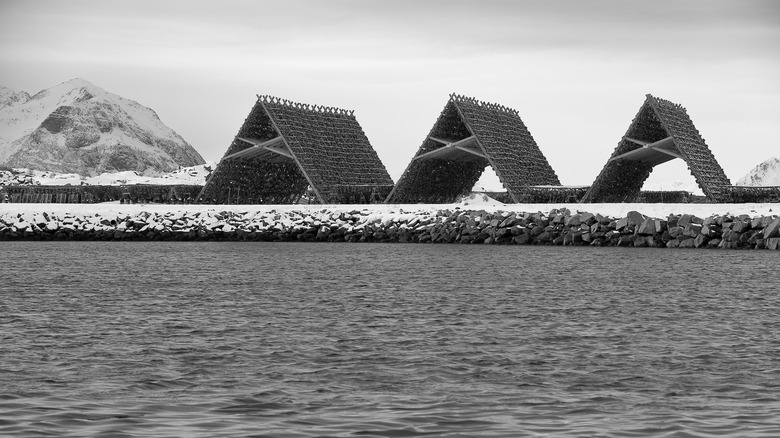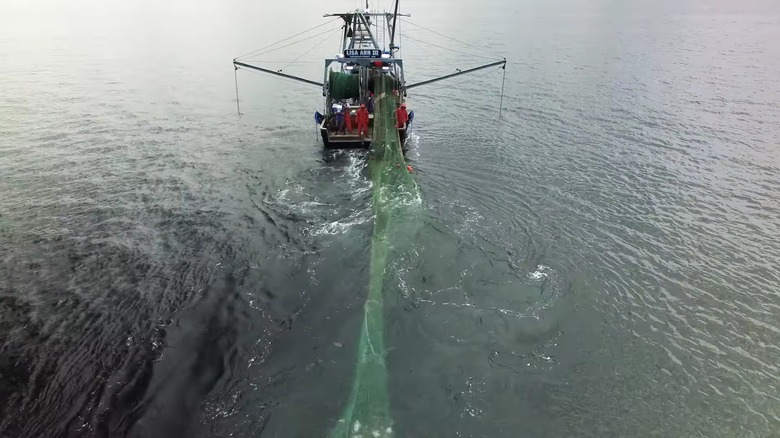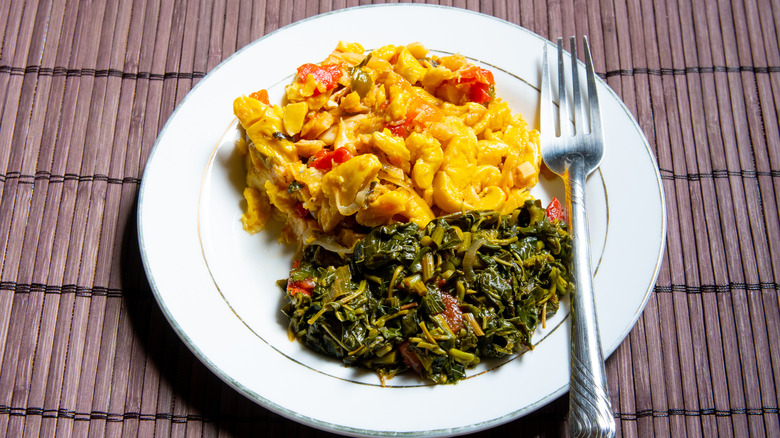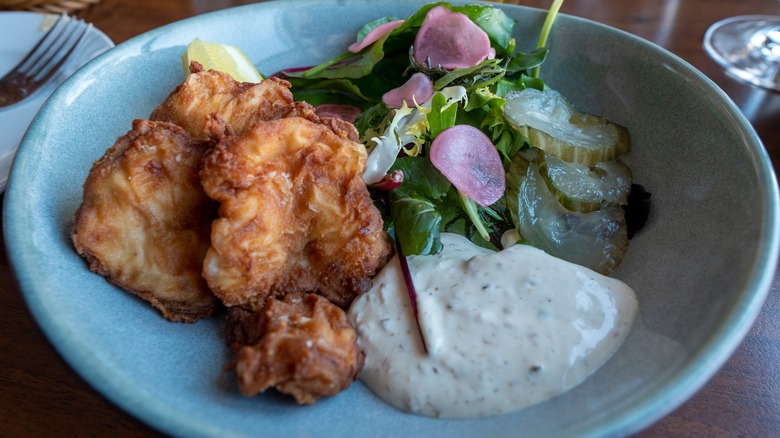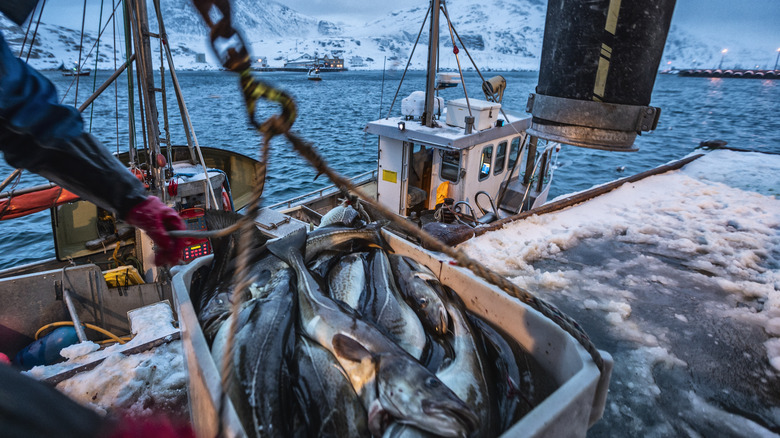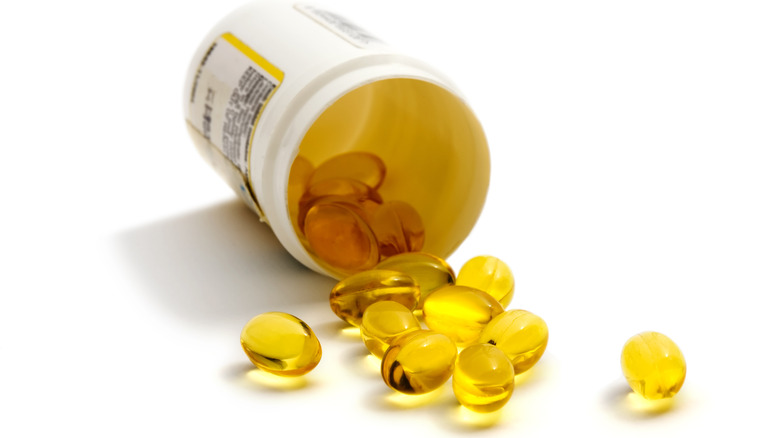What You Need To Know About Cod
As a large, naturally abundant fish, cod has been eaten by various human populations for centuries. That includes modern Americans. As reported by The National Fisheries Institute, Cod sits among the top 10 most consumed seafoods in the United States with the average American eating 0.6 pounds of the fish annually.
Aside from eating them, Americans are also familiar with cod thanks to catching them. In 2022 alone, one million pounds — some 453 tonnes — of cod were caught off America's Atlantic coast. Although this sounds like a lot, it's a far cry from the 810,000 tonnes of Atlantic cod (Gadus morhua) that were caught during 1968 when Atlantic fisheries were at their peak. Numerous factors have contributed to cod populations plummeting and subsequent catch totals dropping. Overfishing and climate change are the two most prevalent of these.
While both of America's Atlantic cod fisheries are overfished, American stocks of Pacific cod (Gadus macrocephalus) are not. What's more, various other cod fisheries are located around the globe, some over-exploited, others not. The fish's prevalence, along with its suitability for eating, means that despite dwindling numbers, cod remains a stalwart of many cuisines. However, there are many things about cod that aren't widely known.
Cod are predators
It might surprise some people to learn that cod hunt for prey. They eat a variety of animals, ranging from worms to lobsters and even small fish. Such a diet means cod are capable of growing up to an impressive length of six feet and a weight of over 100 pounds. However, fishing means that few cod ever make it to these large sizes anymore. Most Atlantic cod caught these days only weigh between 6 to 25 pounds.
As prolific predators, cod keep the population sizes of other species in check. This means that when the cod population is reduced — due to overfishing and warming oceans — it has a huge effect on the rest of the ecosystem. Across Canada's Atlantic coast, for example, diminishing cod populations have caused other species, such as herring and lobster, to explode in number. This, in turn, has further effects throughout the ecosystem in a phenomenon known as trophic cascade.
The two American stocks of Atlantic cod are overfished
The United States has two main Atlantic cod fisheries: The Gulf of Maine and Georges Bank. Both of these fisheries have been, and currently are, subjected to overfishing, according to the National Oceanic and Atmospheric Administration. Such overexploitation has been evident for decades with annual catches plummeting from over 100 million pounds per year in the 1990s to just over one million this decade.
Unfortunately, cod populations have never had a chance to properly rebuild. Part of the reason why is the discrepancy in how scientists and fishers view stocks. Marine biologist Micah Dean explained this in an interview with Northeastern Global News, saying, "We found basically that the federal stock assessment, the scientific perspective, was in general accurate and that the population had declined significantly. [However] The majority of fishermen still think the population has increased."
A recently approved plan has been designed to finally fix this problem. The new plan boasts a 70% chance of rebuilding Atlantic cod stocks by 2033 and will lower the fishing mortality rate to 40% below the maximum sustainable yield for 10 years. Experts hope that keeping to such strict measures can give the Atlantic cod population ample time to become re-established.
North American cod stocks were hugely profitable
Before they became depleted, North American cod stocks played a huge role in both regional and national economies. This was thanks to the incredible abundance of cod in North American waters. In fact, cod were once so prevalent that New Englanders used to say fishermen could walk across water on the fish's backs. Although this is obviously an exaggeration, the cod were so abundant that approximately 10,000 New Englanders — about 8% of the working population of adult men — were employed in the cod fishery industry prior to the American Revolution.
Such a huge business produced vast amounts of money for North America. As chef and author Barton Seaver explained to Eater, "If you look at the total value of cod bought in North America, it outstrips the value of all of the gold mined in South America over time. Cod was really one of the very first stepping stones which the colonies took towards economic and political freedoms."
As a result of the wealth arising from North American cod fisheries, the British parliament imposed taxes and duties on the industry, including banning colonial businessmen and fishermen from trading with the French. This, alongside the enforcement of several other industry-harming laws, played a key role in the American Revolution and eventually forming the United States. The fisheries would continue to be a major source of income for the country until cod populations totally collapsed in the early 1990s.
Huge amounts of fish are being mislabeled as cod
The global demand for cod remains high. When coupled with a limited supply, this demand means cod is now sold for a premium price. In an effort to take advantage of these high prices, some suppliers purposefully mislabel filets of cheaper fish, including pollock, as cod. Seafood Ethics, a free service that presents information on seafood mislabelling, estimates that between six to 20% of fish sold as Atlantic cod is actually a different species altogether.
This type of fraud is by no means relegated to cod alone. In fact, global mislabelling rates for seafood are thought to be as high as 36% on average. Even some restaurants have been known to deliberately mislabel seafood to boost their revenue. The effect these purchases have on the seafood industry, in general, are overwhelmingly negative. Writer Sayara Thurston highlighted to Canada's National Observer, saying, "Seafood fraud has been linked to illegal fishing practices around the globe, which also include things like human rights abuses, or [...] forced labour. And obviously as a consumer, you don't want to be paying more for something and then actually getting a cheaper product."
There are several steps customers can take to ensure the cod they're purchasing is legitimate. The best of these is to build personal relationships with fishmongers and fishermen, and purchase directly from these trusted sources. For those who don't have this option, there are many mail-order seafood suppliers that offer fully traceable fish.
Cod are getting smaller
After decades of overfishing, cod populations aren't the only thing getting smaller; the animals themselves are too. A study published in Philosophical Transactions of the Royal Society B: Biological Sciences states that changes in Atlantic cod's genetic makeup arose due to the pressures placed on the population by mass fishing. These changes led to Atlantic cod becoming smaller and maturing earlier, two adaptations that allowed them to reproduce before they were caught.
In an interview with the U.S. National Science Foundation, Brendan Reid, one of the study's authors, explained, "genes did shift in the same way in cod from both sides of the Atlantic Ocean over the past 100 years. This suggests that cod did indeed evolve in response to fishing through small changes in many genes, something we didn't have clear evidence for before." It's thought that the size reduction in cod populations is reversible. However, extremely long-term management programs are required if the trend is to be stopped. Most estimates suggest that a program with a timescale of around 100 years would be needed.
Confit is the best cooking technique for cod
Despite having a firm, flaky texture, cod is a delicate fish that best responds to gentle cooking techniques. These keep the meat moist and help prevent it from crumbling apart, as easily happens when cod is aggressively pan-fried. While both steamed cod and baked cod are popular dishes, several notable chefs, including Pascal Aussignac, chef and owner of the Michelin-starred Club Gascon in London, prefer to prepare cod confit.
To confit any food it must be submerged in oil and gently heated to around 200 degrees Fahrenheit. Thanks to these low temperatures, foods lose minimal amounts of moisture or flavor when confited, making it a perfect technique for succulent fish like cod. Aussignac explained this in a conversation with Great British Chefs, saying, "Confiting cod helps keep the flakes in the flesh visible and means they will hold their shape. It's not an aggressive cooking method because the oil is heated to a low temperature [...] The flakes will look shiny and the oil will work its way into the centre of the fish." While any fat can be used, most recipes call for olive oil as the grassy, almost spicy flavor perfectly compliments the fish's natural taste.
Cod is a key part of Portuguese cuisine
Despite not being found in Portuguese waters, cod is a hugely important part of the country's cuisine and is often touted as one of the foods to try when visiting Portugal. The country's love of cod stems from Portugal's history as a naval superpower; salted fish was often carried on ships as it lasted for long durations without spoiling. Portuguese seamanship also gave the country access to the cod-rich waters of North America. After catching the fish, they transformed it into bacalhau, a type of salted cod that became a common food back in Portugal.
The fact bacalhau was a tasty, versatile, and cheap protein wasn't the only reason it became popular in Portugal. Religion also played a role. Barton Seaver highlights this to Eater, saying, "The Catholic church, in years past, had 150 different fast days in its calendar when you were to abstain from meat, so salt cod filled that role to a very large extent."
In 1934, António de Oliveira Salazar, a dictator, launched something called the Codfish Campaign — a drive to make bacalhau the country's staple food and the industry a major employer. Thanks to propaganda, the campaign took hold and cod became a national symbol, causing both production and consumption of bacalhau to leap. The campaign ended after Salazar died, but bacalhau is still viewed as a key part of Portuguese identity.
Cod cures incredibly well
The Portuguese were not the first to cure cod. In fact, the fish had been cured for centuries before they developed a taste for bacalhau. The Vikings were curing cod from as early as the eighth century and using it as food for long voyages. The way they cured cod was very simple; the gutted fish was simply left out on a surface and dried in open air.
Other fish would quickly go bad if cured in such a manner, but the vast majority of cod's fat is stored in its liver, meaning the flesh does not go rancid easily. Discussing this with Eater by Barton Seaver highlighted the characteristics that make cod an easily curable fish, explaining, "So that low fat content, high moisture content, and high protein content meant you could salt it or just sun dry it, even wind dry it, and turn it into a tradable, lasting, durable commodity."
Thanks to refrigeration, curing cod is no longer the necessity it once was. However, many people continue to cure cod for gastronomic reasons, as it alters the fish's texture, which becomes firmer, and its flavor, which becomes more intense. For these reasons, it's a feature of restaurant menus including Alma, a two Michelin-starred restaurant in Lisbon.
The Gulf of Maine fishery is changing rapidly
It's well known that cod stocks in the Gulf of Maine have been overfished for decades, resulting in a catastrophic population crash in the early 1990s. Attempts to rebuild the population have struggled and scientists are now suggesting that climate change is partly to blame.
The Gulf of Maine is warming quicker than any other part of the world's oceans. This is thought to be due to a northward shift in the warm water-carrying Gulf Stream and the general increases in temperature seen around the globe. All of this has contributed to the Gulf of Maine warming at a rate three times greater than the rest of the world's oceans, increasing in temperature by about 0.86 Fahrenheit per decade. The effect this warming has on cod is multifaceted. As scientist Michael Fogarty highlighted to The New York Times, "As temperatures increase, those population that are already at the margins are more stressed. For coldblooded animals like cod, temperature changes affect virtually every part of their life, their physiology, their reproduction, their eating habits."
The upshot of this is that programs designed to rebuild the cod population in the Gulf of Maine have not been as successful as initially hoped. What's more, a lack of cod has seen other fish species rise to prominence in the area, including dogfish. This change in the ecosystem makes rebuilding the cod population an even more challenging proposition.
Salt cod was used to feed enslaved people
Between the 16th and 19th centuries around five million people were sent to the Caribbean as slaves. Here, the vast majority worked on sugar plantations in dire conditions. To maximize their profits, many plantation owners chose to not grow crops on their land and instead purchased food for their enslaved workforce from external sources. As a cheap, long-lasting food product, salt cod became a staple plantation food. This fish was not the same quality as those sold to European markets. In fact, the salt cod sold to the plantations was generally low-grade and would have otherwise been discarded.
The associations between salt cod and the slave trade only deepened as the years went by and trade developed. Instead of returning empty, many of the cod-depositing vessels filled their hulls with products produced by slave labor, namely sugar. Others went a step further, sailing across the Atlantic to purchase and transport slaves themselves. The result was a hugely profitable trans-Atlantic trading cycle that was directly built upon the abuse, exploitation, and subjugation of millions of people.
Given salt cod's long association with the Caribbean, it is no surprise that it remains an important food in the region today. In Jamaica, salt cod is most famously served alongside ackee, a fruit of Ghanaian origin, in the dish ackee and saltfish. As the national dish, ackee and saltfish is an essential part of Jamaican identity.
Cod tongues are a Canadian delicacy
In Newfoundland, cod tongues, a lesser-known part of cod, are served up as a local delicacy. Despite the name, they are not tongues at all but a muscle that's cut from the fish's throat. This scallop-sized piece of flesh is known to have a meatier texture than the rest of the fish and is usually battered and served alongside crisp pieces of pork fat called scrunchions. This delicacy only came to prominence once cod became scarcer and more emphasis was placed on using every part of the animal.
Cod tongues are also popular in Norway, a country that boasts robust cod fisheries. Here, children are often employed to cut the cod tongue from the carcass. In fact, fishing companies actually donate the cod heads to children, giving them an opportunity to experience the area's traditional industry and earn thousands of dollars while doing so. A documentary "Tongue Cutters" was even released in 2017, revealing the ins and outs of this decades-old tradition.
Some believe Norwegian cod is the best
Norway is known to produce a particularly high-quality type of cod known locally as skrei. These are Atlantic cod that swim along the Russian and Norwegian coasts and the incredibly cold waters result in firm, well-muscled fish that boasts a uniquely pure flavor. Chef Ollie Dabbous spoke about skrei to Great British Chefs, saying, "What I love about this fish is the texture of the flesh. It's got this amazing firmness to it and it never feels pappy or fatty, which you can sometimes get with other big fish."
Less than 10% of all cod caught off the coast of Norway is classified as skrei, due to the high standards that must be met. To be labeled skrei, fish must be devoid of any blemishes and be cleaned at sea to ensure the meat remains as white as possible. Such quality demands gentle cooking processes with chefs such as Roy Magne Berglund preferring to bake the fish for long durations at very low temperatures.
Cod liver oil has been a supplement for centuries
Cod liver oil, one of the best food sources of vitamin D, is a popular supplement. Nearly 19 million Americans take fish oil supplements such as cod liver oil, believing it has a variety of health benefits. These include the prevention of cardiovascular disease and an ability to reduce the pain associated with arthritis. It's thought the health benefits associated with taking the supplement are due to the high amounts of omega-3 fatty acids and vitamins A and D it contains. However, the validity of cod liver oil's purported health benefits has been challenged by numerous scientific studies with many suggesting that cod liver oil supplementation has no impact on the aforementioned diseases.
One disease that cod liver oil does have a pronounced impact on is rickets, a bone disease that develops in children due to a lack of vitamin D. In Victorian Britain, rickets became a public health issue that affected the urban poor who had limited exposure to sunlight. Eventually, cod liver oil was found to prevent the development of rickets and was subsequently offered as a mass supplement.
Cod liver oil was being extracted and consumed for medical purposes even prior to the Victorian era, however. The Vikings were known to extract cod liver oil by steaming the livers above a pot of water before skimming the dripping oil from the water's surface. The oil was subsequently drunk to boost overall health.
